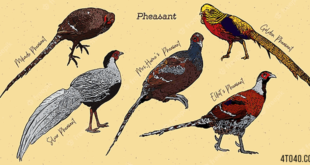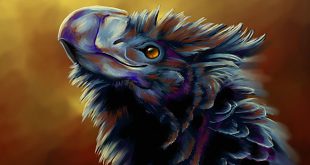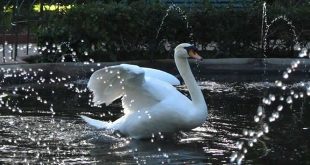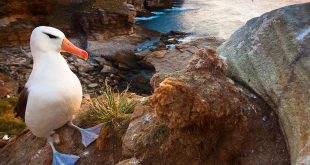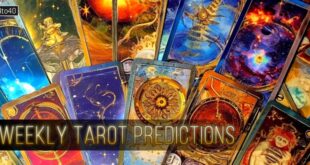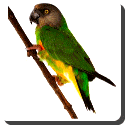 Parrot — Parrots, also known as psittacines are birds of the roughly 372 species in 86 genera that make up the order Psittaciformes, found in most tropical and subtropical regions. The order is subdivided into three families: the Psittacidae (’true’ parrots), the Cacatuidae (cockatoos) and the Strigopidae (New Zealand parrots). Parrots have a generally pantropical distribution with several species inhabiting temperate regions in the Southern Hemisphere as well. The greatest diversity of parrots is found in South America and Australasia.
Parrot — Parrots, also known as psittacines are birds of the roughly 372 species in 86 genera that make up the order Psittaciformes, found in most tropical and subtropical regions. The order is subdivided into three families: the Psittacidae (’true’ parrots), the Cacatuidae (cockatoos) and the Strigopidae (New Zealand parrots). Parrots have a generally pantropical distribution with several species inhabiting temperate regions in the Southern Hemisphere as well. The greatest diversity of parrots is found in South America and Australasia.
Characteristic features of parrots include a strong, curved bill, an upright stance, strong legs, and clawed zygodactyl feet. Many parrots are vividly coloured, and some are multi-coloured. The plumage of cockatoos ranges from mostly white to mostly black, with a mobile crest of feathers on the tops of their heads. Most parrots exhibit little or no sexual dimorphism. They form the most variably sized bird order in terms of length.
The most important components of most parrots’ diets are seeds, nuts, fruit, buds and other plant material. A few species sometimes eat animals and carrion, while the lories and lorikeets are specialised for feeding on floral nectar and soft fruits. Almost all parrots nest in tree hollows (or nest boxes in captivity), and lay white eggs from which hatch altricial (helpless) young.
Parrots, along with ravens, crows, jays and magpies, are among the most intelligent birds, and the ability of some species to imitate human voices enhances their popularity as pets. Trapping wild parrots for the pet trade, as well as hunting, habitat loss and competition from invasive species, has diminished wild populations, with parrots being subjected to more exploitation than any other group of birds. Measures taken to conserve the habitats of some high-profile charismatic species have also protected many of the less charismatic species living in the same ecosystems.
There are numerous difficulties in studying wild parrots, as they are difficult to catch and once caught they are difficult to mark. Most wild bird studies rely on banding or wing tagging, but parrots will chew off such attachments. Parrots also tend to range widely and consequently there are many gaps in knowledge of their behaviour.
Parrots have a strong, direct flight. Most species spend much of their time perched or climbing in tree canopies. They often use their bills for climbing by gripping or hooking on branches and other supports. On the ground parrots often walk with a rolling gait.
The diet of parrots consists of seeds, fruit, nectar, pollen, buds, and sometimes arthropods and other animal prey. The most important of these for most true parrots and cockatoos are seeds; the evolution of the large and powerful bill can be explained primarily as an adaptation to opening and consuming seeds. All true parrots except the Pesquet’s Parrot employ the same method to obtain the seed from the husk; the seed is held between the mandibles and the lower mandible crushes the husk, whereupon the seed is rotated in the bill and the remaining husk is removed. A foot is sometimes used to help holding large seeds in place. Parrots are seed predators rather than seed dispersers; and in many cases where species are recorded as consuming fruit they are only eating the fruit to get at the seed. As seeds often have poisons to protect them, parrots are careful to remove seed coats and other fruit parts which are chemically well defended, prior to ingestion. Many species in the Americas, Africa, and Papua New Guinea consume clay which both releases minerals and absorbs toxic compounds from the gut.
The lories and lorikeets, hanging parrots and Swift Parrot are primarily nectar and pollen consumers, and have tongues with brush tips to collect this source of food, as well as some specialised gut adaptations to accommodate this diet. Many other species also consume nectar as well when it becomes available.
In addition to feeding on seeds and flowers, some parrot species will prey on animals, especially invertebrate larvae. Golden-winged Parakeets prey on water snails, and famously the Keas of New Zealand will kill juvenile petrels and even attack and indirectly kill adult sheep. Another New Zealand parrot, the Antipodes Island Parakeet, enters the burrows of nesting Grey-backed Storm Petrels and kills the incubating adults. Some cockatoos and the Kâkâ will excavate branches and wood to obtain grubs.
Although there are a few exceptions, parrots are monogamous breeders which nest in cavities and hold no territories other than their nesting sites. The pair bonds of the parrots and cockatoos are strong and a pair will remain close even during the non-breeding season, even if they join larger flocks. As with many birds, pair bond formation is preceded by courtship displays; these are relatively simple in the case of cockatoos. In Psittacidae parrots common breeding displays, usually undertaken by the male, include slow deliberate steps known as a “parade” or “stately walk” and the “eye-blaze”, where the pupil of the eye constricts to reveal the edge of the iris. Allopreening is used by the pair to help maintain the bond. Cooperative breeding, where birds other than the breeding pair help the pair raise the young and is common in some bird families, is extremely rare in parrots, and has only unambiguously been demonstrated in the Golden Parakeet (which may also exhibit polyamorous, or group breeding, behaviour with multiple females contributing to the clutch).
The eggs of parrots are white. In most species the female undertakes all the incubation, although incubation is shared in cockatoos, the Blue Lorikeet, and the Vernal Hanging Parrot. The female remains in the nest for almost all of the incubation period and is fed both by the male and during short breaks. Incubation varies from 17 to 35 days, with larger species having longer incubation periods. The newly born young are altricial, either lacking feathers or with sparse white down. The young spend anything from three weeks to four months in the nest, depending on species, and may receive parental care for several months thereafter.
 Kids Portal For Parents India Kids Network
Kids Portal For Parents India Kids Network

